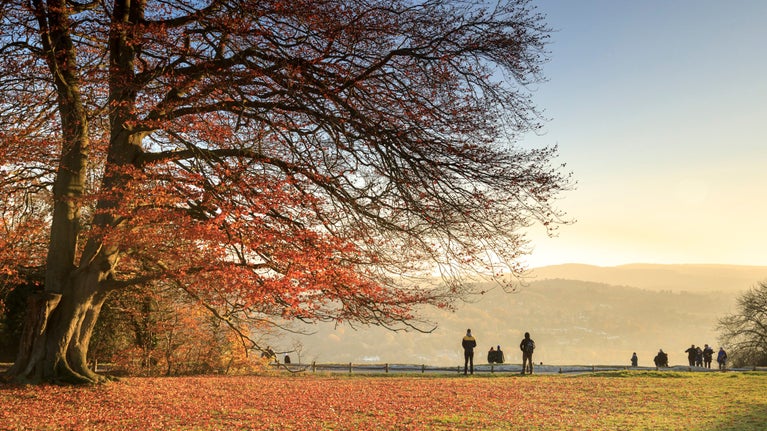
Help plant more trees
For only £10, you can plant a tree that will tackle climate change and support life for years to come. Your support will help to plant and establish 20 million trees by 2030.

Our research shows that orchards and hedgerows are disappearing. This means there's a smaller number of natural habitats for wildlife, and fewer people are able to witness the spectacle of spring blossom. However, we believe there's still time to bring blossom back to UK landscapes, which is why we're planting millions of blossom trees and creating new hedgerows at the places we look after.
Understanding the historic loss of blossom across landscapes and its impact on wildlife is vital in helping us look after nature. We've been using historical records and maps, along with tools like machine learning, to shed light on how this loss has drastically changed our landscape.
Our research into hedgerows on land we care for in England and Wales shows that 33 per cent, nearly 3,300km of boundaries, have disappeared since the start of the 20th century. Beyond the land we look after, the loss of hedgerows is estimated to be even greater at around 50 per cent – the most significant area of loss is the East of England, which has lost nearly half (48 per cent) of its hedgerows.
Our research on orchards reflects a similar story of loss, showing that more than half (56 per cent) of orchards have been lost. Traditional orchards, which are particularly beneficial for wildlife, have also decreased by 81 per cent – this is equivalent to an area the size of the West Midlands.
Hedges have a vital role to play in the natural world. They help wildlife move around landscapes, provide food and shelter for many species and store carbon. Their bursts of blossom – blackthorn, hawthorn, dog rose, wild cherry, apple and plum – are not only striking but are also a good source of nectar for bumblebees and butterflies. The fruit they produce in autumn is eaten by flocks of migrating and overwintering birds, including redwings and fieldfares. The trunks and branches of traditional varieties of fruit trees are great homes for rare species, such as the noble chafer beetle, and are excellent hunting areas for bats. Not only this, but the blossom attracts pollinators, which are vital to our ecosystem.
For hundreds of years, orchards were a defining feature in many places, part of the fabric of everyday life. Their loss impacts on the stories we can tell, the culture and history we can experience in the landscape, and it means fewer opportunities for people to enjoy the beauty and spectacle of blossom today.

For hundreds of years, blossoming trees have been a defining feature in many locations and have even influenced the names given to many streets and local areas. As part of our 2024 celebration of blossom, we used modern and historic maps to look at the history of blossoming trees through these place names. In 2023, we found that out of the 912,000 place names we recorded, around 50,000 (six per cent) were blossom-related; the most popular street names were 'Orchard Close', 'Orchard Way', 'Chestnut Close' and 'Chestnut Avenue'. Even though so many of our orchards have disappeared, our connection to them lives on in these place names. Discovering these historic blossom sites could point the way for future blossom reintroduction projects, restoring these places to their former state.
As part of our commitment to plant and establish 20 million trees across England, Wales and Northern Ireland by 2030, we want to plant four million blossoming trees. Planting native and historic varieties, and other trees such as blackthorn and hawthorn, is vital to supporting nature.
We're planting traditional orchards at places such as Glastonbury Tor in Somerset and the Greenway in Belfast, and fruit trees in the Lake District in Cumbria, Crook Hall Gardens in Durham and Horsey Windpump in Norfolk. We're also introducing five miles of blossoming trees across Lewisham in London.
Over the next five years, we’ll be continuing our ambition to bring back blossom to areas that could greatly benefit from it. Blossom trees are being planted in cities such as Newcastle, London, Plymouth and Birmingham, to ensure urban communities can come together and experience nature.
We've also been working to restore hedgerow loss. In the last 20 years, we've planted a total of 220km of hedgerows across many places in our care, including Killerton in Devon, Dunham Massey in Cheshire and Wallington in Northumberland. We're planting 125km of additional hedgerows at these places over the next decade as part of our commitment to become net zero.

For only £10, you can plant a tree that will tackle climate change and support life for years to come. Your support will help to plant and establish 20 million trees by 2030.
From ornamental magnolias in gardens to blackthorn scattered across the countryside, discover some of the best places to see blossom in our care.

Discover how we work to support a rich variety of land, nature and wildlife across England, Wales and Northern Ireland.

With support from the Government’s Green Recovery Challenge Fund, we're looking for ways to protect our environment and combat climate change. Find out more about the work we're doing.
